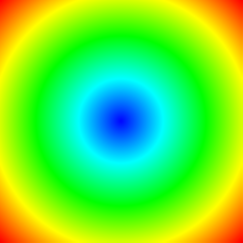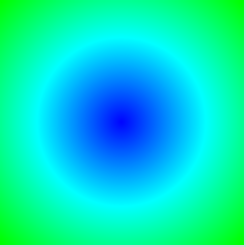C++如何实现基于灰度图上色GrayToColorFromOthe
小编给大家分享一下C++如何实现基于灰度图上色GrayToColorFromOthe,相信大部分人都还不怎么了解,因此分享这篇文章给大家参考一下,希望大家阅读完这篇文章后大有收获,下面让我们一起去了解一下吧!
场景需求
之前有提到给灰度图上色的需求,在此基础上,还有一种需求,就是基于另一张参考灰度图的色板来给当前的灰度图上色,比如参考灰度图的数值区间为-10到10,颜色从蓝到绿再到红,而当前的灰度图的数据区间为-1到1,若基于参考灰度图的色板确定数据对应的颜色,则当前灰度图的颜色应该在绿色左右波动。
下方为具体实现函数和测试代码。
功能函数代码
cv::Mat GrayToColorFromOther(cv::Mat &phase1, cv::Mat &phase2){CV_Assert(phase1.channels() == 1);CV_Assert(phase2.channels() == 1);if (phase1.empty() || phase2.empty()){cv::Mat result = cv::Mat::zeros(100, 100, CV_8UC3);return result;}cv::Mat temp, result, mask;double max1, min1;int row = phase2.rows;int col = phase2.cols;// 确定参考灰度图的数据范围cv::minMaxIdx(phase1, &min1, &max1, nullptr, nullptr, phase1 == phase1);// 将当前灰度图以参考灰度图的数据范围作标准,进行数据变换temp = phase2.clone();for (int i = 0; i < row; ++i){float *t2 = temp.ptr<float>(i);for (int j = 0; j < col; ++j){t2[j] = 255.0f*(phase2.at<float>(i, j) - min1) / (max1 - min1);}}temp.convertTo(temp, CV_8UC1);// 创建掩膜,目的是为了隔离nan值的干扰mask = cv::Mat::zeros(phase2.size(), CV_8UC1);mask.setTo(255, phase2 == phase2); // 初始化三通道颜色图cv::Mat color1, color2, color3;color1 = cv::Mat::zeros(temp.size(), temp.type());color2 = cv::Mat::zeros(temp.size(), temp.type());color3 = cv::Mat::zeros(temp.size(), temp.type()); // 基于灰度图的灰度层级,给其上色,最底的灰度值0为蓝色(255,0,0),最高的灰度值255为红色(0,0,255),中间的灰度值127为绿色(0,255,0)for (int i = 0; i < row; ++i){uchar *c1 = color1.ptr<uchar>(i);uchar *c2 = color2.ptr<uchar>(i);uchar *c3 = color3.ptr<uchar>(i);uchar *r = temp.ptr<uchar>(i);uchar *m = mask.ptr<uchar>(i);for (int j = 0; j < col; ++j){if (m[j] == 255){if (r[j] > (3 * 255 / 4) && r[j] <= 255){c1[j] = 255;c2[j] = 4 * (255 - r[j]);c3[j] = 0;}else if (r[j] <= (3 * 255 / 4) && r[j] > (255 / 2)){c1[j] = 255 - 4 * (3 * 255 / 4 - r[j]);c2[j] = 255;c3[j] = 0;}else if (r[j] <= (255 / 2) && r[j] > (255 / 4)){c1[j] = 0;c2[j] = 255;c3[j] = 4 * (255 / 2 - r[j]);}else if (r[j] <= (255 / 4) && r[j] >= 0){c1[j] = 0;c2[j] = 255 - 4 * (255 / 4 - r[j]);c3[j] = 255;}else {c1[j] = 0;c2[j] = 0;c3[j] = 0;}}}} // 三通道合并,得到颜色图vector<cv::Mat> images;images.push_back(color3);images.push_back(color2);images.push_back(color1);cv::merge(images, result); return result;}C++测试代码
#include<iostream>#include<opencv2/opencv.hpp>#include<ctime>using namespace std;using namespace cv; void UnitPolar(int squaresize, cv::Mat& mag,cv::Mat& ang);void UnitCart(int squaresize, cv::Mat& x, cv::Mat& y);cv::Mat GrayToColor(cv::Mat &phase);cv::Mat GrayToColorFromOther(cv::Mat &phase1, cv::Mat &phase2); int main(void){cv::Mat mag, ang,result,result2;UnitPolar(2001, mag, ang);mag.at<float>(10, 10) = nan("");cv::Mat mag2 = mag / 2; result = GrayToColor(mag);result2= GrayToColorFromOther(mag,mag2); system("pause");return 0;} void UnitPolar(int squaresize, cv::Mat& mag,cv::Mat& ang) {cv::Mat x;cv::Mat y;UnitCart(squaresize, x, y); //产生指定范围内的指定数量点数,相邻数据跨度相同// OpenCV自带的转换有精度限制,导致结果有一定差异性//cv::cartToPolar(x, y, mag, ang, false); //坐标转换 mag = cv::Mat(x.size(), x.type());ang = cv::Mat(x.size(), x.type());int row = mag.rows;int col = mag.cols;float *m, *a, *xx, *yy;for (int i = 0; i < row; ++i){m = mag.ptr<float>(i);a = ang.ptr<float>(i);xx = x.ptr<float>(i);yy = y.ptr<float>(i);for (int j = 0; j < col; ++j){m[j] = sqrt(xx[j] * xx[j] + yy[j] * yy[j]);a[j] = atan2(yy[j], xx[j]);}}} void UnitCart(int squaresize, cv::Mat& x, cv::Mat& y) {CV_Assert(squaresize % 2 == 1);x.create(squaresize, squaresize, CV_32FC1);y.create(squaresize, squaresize, CV_32FC1);//设置边界x.col(0).setTo(-1.0);x.col(squaresize - 1).setTo(1.0f);y.row(0).setTo(1.0);y.row(squaresize - 1).setTo(-1.0f); float delta = 2.0f / (squaresize - 1.0f); //两个元素的间隔 //计算其他位置的值for (int i = 1; i < squaresize - 1; ++i) {x.col(i) = -1.0f + i * delta;y.row(i) = 1.0f - i * delta;}} cv::Mat GrayToColor(cv::Mat &phase){CV_Assert(phase.channels() == 1); cv::Mat temp, result, mask;// 将灰度图重新归一化至0-255cv::normalize(phase, temp, 255, 0, cv::NORM_MINMAX);temp.convertTo(temp, CV_8UC1);// 创建掩膜,目的是为了隔离nan值的干扰mask = cv::Mat::zeros(phase.size(), CV_8UC1);mask.setTo(255, phase == phase); // 初始化三通道颜色图cv::Mat color1, color2, color3;color1 = cv::Mat::zeros(temp.size(), temp.type());color2 = cv::Mat::zeros(temp.size(), temp.type());color3 = cv::Mat::zeros(temp.size(), temp.type());int row = phase.rows;int col = phase.cols; // 基于灰度图的灰度层级,给其上色,最底的灰度值0为蓝色(255,0,0),最高的灰度值255为红色(0,0,255),中间的灰度值127为绿色(0,255,0)// 不要惊讶蓝色为什么是(255,0,0),因为OpenCV中是BGR而不是RGBfor (int i = 0; i < row; ++i){uchar *c1 = color1.ptr<uchar>(i);uchar *c2 = color2.ptr<uchar>(i);uchar *c3 = color3.ptr<uchar>(i);uchar *r = temp.ptr<uchar>(i);uchar *m = mask.ptr<uchar>(i);for (int j = 0; j < col; ++j){if (m[j] == 255){if (r[j] > (3 * 255 / 4) && r[j] <= 255){c1[j] = 255;c2[j] = 4 * (255 - r[j]);c3[j] = 0;}else if (r[j] <= (3 * 255 / 4) && r[j] > (255 / 2)){c1[j] = 255 - 4 * (3 * 255 / 4 - r[j]);c2[j] = 255;c3[j] = 0;}else if (r[j] <= (255 / 2) && r[j] > (255 / 4)){c1[j] = 0;c2[j] = 255;c3[j] = 4 * (255 / 2 - r[j]);}else if (r[j] <= (255 / 4) && r[j] >= 0){c1[j] = 0;c2[j] = 255 - 4 * (255 / 4 - r[j]);c3[j] = 255;}else {c1[j] = 0;c2[j] = 0;c3[j] = 0;}}}} // 三通道合并,得到颜色图vector<cv::Mat> images;images.push_back(color3);images.push_back(color2);images.push_back(color1);cv::merge(images, result); return result;} cv::Mat GrayToColorFromOther(cv::Mat &phase1, cv::Mat &phase2){CV_Assert(phase1.channels() == 1);CV_Assert(phase2.channels() == 1);if (phase1.empty() || phase2.empty()){cv::Mat result = cv::Mat::zeros(100, 100, CV_8UC3);return result;}cv::Mat temp, result, mask;double max1, min1;int row = phase2.rows;int col = phase2.cols;// 确定参考灰度图的数据范围cv::minMaxIdx(phase1, &min1, &max1, nullptr, nullptr, phase1 == phase1);// 将当前灰度图以参考灰度图的数据范围作标准,进行数据变换temp = phase2.clone();for (int i = 0; i < row; ++i){float *t2 = temp.ptr<float>(i);for (int j = 0; j < col; ++j){t2[j] = 255.0f*(phase2.at<float>(i, j) - min1) / (max1 - min1);}}temp.convertTo(temp, CV_8UC1);// 创建掩膜,目的是为了隔离nan值的干扰mask = cv::Mat::zeros(phase2.size(), CV_8UC1);mask.setTo(255, phase2 == phase2); // 初始化三通道颜色图cv::Mat color1, color2, color3;color1 = cv::Mat::zeros(temp.size(), temp.type());color2 = cv::Mat::zeros(temp.size(), temp.type());color3 = cv::Mat::zeros(temp.size(), temp.type()); // 基于灰度图的灰度层级,给其上色,最底的灰度值0为蓝色(255,0,0),最高的灰度值255为红色(0,0,255),中间的灰度值127为绿色(0,255,0)for (int i = 0; i < row; ++i){uchar *c1 = color1.ptr<uchar>(i);uchar *c2 = color2.ptr<uchar>(i);uchar *c3 = color3.ptr<uchar>(i);uchar *r = temp.ptr<uchar>(i);uchar *m = mask.ptr<uchar>(i);for (int j = 0; j < col; ++j){if (m[j] == 255){if (r[j] > (3 * 255 / 4) && r[j] <= 255){c1[j] = 255;c2[j] = 4 * (255 - r[j]);c3[j] = 0;}else if (r[j] <= (3 * 255 / 4) && r[j] > (255 / 2)){c1[j] = 255 - 4 * (3 * 255 / 4 - r[j]);c2[j] = 255;c3[j] = 0;}else if (r[j] <= (255 / 2) && r[j] > (255 / 4)){c1[j] = 0;c2[j] = 255;c3[j] = 4 * (255 / 2 - r[j]);}else if (r[j] <= (255 / 4) && r[j] >= 0){c1[j] = 0;c2[j] = 255 - 4 * (255 / 4 - r[j]);c3[j] = 255;}else {c1[j] = 0;c2[j] = 0;c3[j] = 0;}}}} // 三通道合并,得到颜色图vector<cv::Mat> images;images.push_back(color3);images.push_back(color2);images.push_back(color1);cv::merge(images, result); return result;}测试效果

图1 参考灰度图上色效果

图2 基于参考灰度图色板的上色效果
如上图所示,为了方便,我生成了一个2001*2001的图像矩阵,并设置了另一个对比图像,该图像为原图像的1/2,那么原图像就是参考灰度图,而对比图像就是需要基于参考灰度图色板上色的灰度图。图1为参考灰度图的上色效果,图2是基于参考灰度图色板给对比图像上色的效果图。原图像的数据从0-1.3左右,其颜色变化从蓝到绿再到红,而对比图像的数据从0-1.3/2左右,则颜色变化为蓝到绿,满足了前面提到的需求。
以上是“C++如何实现基于灰度图上色GrayToColorFromOthe”这篇文章的所有内容,感谢各位的阅读!相信大家都有了一定的了解,希望分享的内容对大家有所帮助,如果还想学习更多知识,欢迎关注编程网行业资讯频道!
免责声明:
① 本站未注明“稿件来源”的信息均来自网络整理。其文字、图片和音视频稿件的所属权归原作者所有。本站收集整理出于非商业性的教育和科研之目的,并不意味着本站赞同其观点或证实其内容的真实性。仅作为临时的测试数据,供内部测试之用。本站并未授权任何人以任何方式主动获取本站任何信息。
② 本站未注明“稿件来源”的临时测试数据将在测试完成后最终做删除处理。有问题或投稿请发送至: 邮箱/279061341@qq.com QQ/279061341














